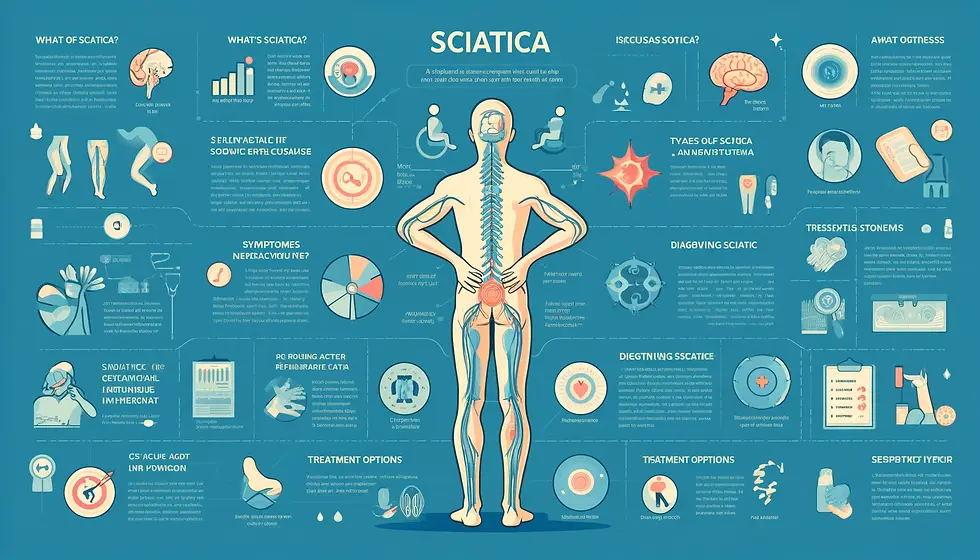Sciatica Causes, Symptoms, Diagnosis, and Treatment
- Doctoury
- May 29, 2024
- 2 min read
Updated: Mar 8
Sciatica Causes Symptoms Diagnosis and Treatment
Sciatica is a common condition that affects many people, causing pain and discomfort along the sciatic nerve. This blog aims to provide comprehensive information about sciatica, including its types, causes, symptoms, diagnostic methods, treatment options, and prevention strategies. Whether you are currently experiencing sciatic pain or simply want to educate yourself, this guide will offer valuable insights and practical advice.
Sciatica refers to pain that radiates along the path of the sciatic nerve, which branches from your lower back through your hips and buttocks and down each leg. Typically, sciatica affects only one side of your body and is often the result of nerve compression.

Sciatica is generally categorized into two main types:
Acute Sciatica: This is a temporary condition that lasts from a few days to a few weeks. It typically resolves with minimal treatment.
Chronic Sciatica: This type persists for more than three months and might stem from more serious medical conditions like lumbar spinal stenosis or spondylolisthesis.
The primary reasons for sciatica include:
Herniated Disc: The most common cause where a disc protrudes and puts pressure on the sciatic nerve.
Spinal Stenosis: Narrowing of the spinal canal that compresses the nerve.
Piriformis Syndrome: When the piriformis muscle, located in the buttock region, spasms and irritates the sciatic nerve.
Spondylolisthesis: A condition where one vertebra slips over another.
Key symptoms of sciatica include:
Pain: Ranging from mild ache to a sharp, burning sensation or excruciating discomfort.
Numbness: Experiencing a lack of feeling in the affected leg.
Weakness: A reduction in strength of the leg or foot.
Pins and Needles: Tingling sensations typically felt in the toes or foot.
To diagnose sciatica, healthcare providers may use:
Physical Examination: Focusing on your spine, legs, and reflexes.
Imaging Tests: Such as X-rays, MRI scans, or CT scans to identify the underlying cause of the nerve compression.
Nerve Tests: Electromyography (EMG) to measure the electrical impulses of the muscles.
Treatment options vary based on the severity of symptoms and underlying causes but may include:
Medication: Pain relievers, anti-inflammatories, and muscle relaxants.
Physical Therapy: Exercises to strengthen the back and abdominal muscles.
Steroid Injections: To reduce inflammation around the nerve.
Surgery: In severe cases, procedures like discectomy or laminectomy might be necessary.
Preventative measures include:
Exercise Regularly: Maintaining strength and flexibility can prevent nerve compression.
Proper Posture: Use good body mechanics when standing, sitting, and lifting.
Ergonomic Workspace: Arrange your workspace to minimize back strain.
Understanding sciatica and its potential impact on your life is crucial for managing and preventing this painful condition. By recognizing the symptoms early and consulting with a healthcare provider, you can determine the most effective treatment plan and take proactive steps towards recovery. Remember, maintaining a healthy lifestyle is key to preventing sciatica and improving your overall well-being.
Commentaires